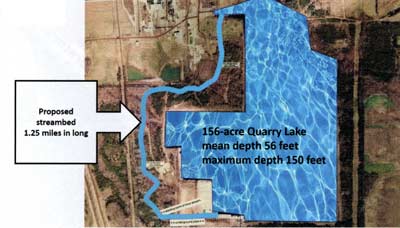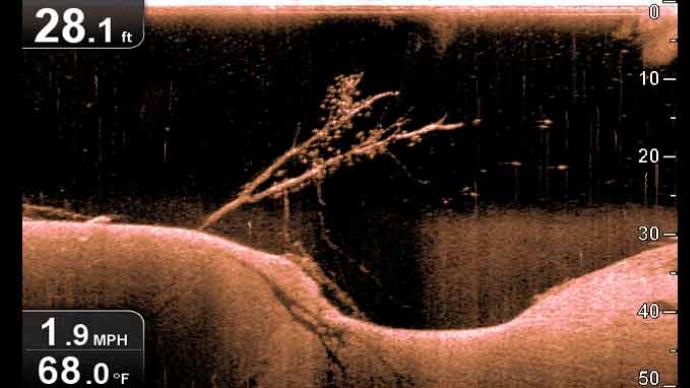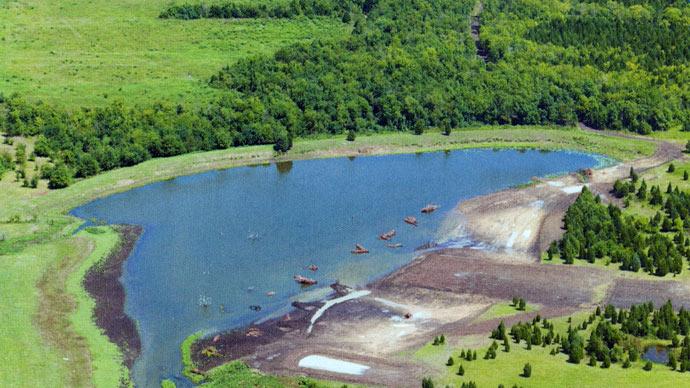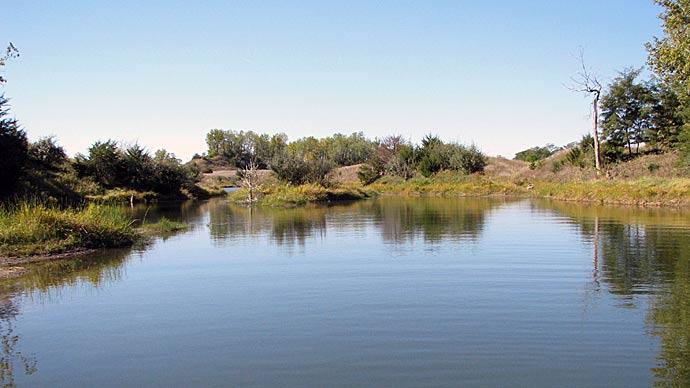
In the pond world, it is not uncommon to have pondmeisters propose some ingenious ideas. From using an airboat to blow limestone into the pond to creating upstream nursery ponds for prey drained to feed bass, you guys are thinking outside the box.
But now and then, an idea so off-the-wall is proposed that it gets me thinking. Usually, I can use my science training to dismiss the idea outright. Other times, I just feel that it won't work. But when I am offered a truly outrageous idea, and I cannot dismiss it, my job gets fun.
Enter Will. Having retired from several professions, Will has the means, connections, and fortitude to try novel ideas, and the idea he approached me with is as novel as they get. He has an old cement plant property in the deepest part of the deep southeastern United States. The property has a quarry that, since commercial operations ended, has been slowly filling for the last three years with groundwater and runoff. The most recent hydrology study projected that filling would take 11 years (with wetter-than-normal weather) to 15 years (with average rainfall). Still, it will eventually be 156 surface acres, averaging 65 feet deep, with several deeper areas approaching 150 feet deep. A big, deep lake with clean water. It has already been stocked with bass and bream, but this story is headed elsewhere.
The previous owners used several 3-phase, 12-inch pumps to keep the quarry dry from the numerous springs encountered while mining the limestone. Those pumps come with the property. Will also plans to invest in additional solar pumps. For what, you ask?
Here is where things get interesting. Will's dream is to create an artificial stream that begins on the south side of the quarry and wraps through the woods to the west for 1.25 miles before dumping back into the lake on the north end. There is a 30-foot elevation change in the planned streambed. Initial planning included a streambed with a 100-foot width and an average depth of 2.5 feet, so Will would have to move about 62,000 cubic yards of material to make this streambed a reality. Of course, this design is subject to revision.
He plans to pump water from the cold, deep waters of the lake up to the stream head, where it will flow down the streambed and create the stream. Yes, cold water. Do you see where this is going? You guessed it. His dream is to create the only trophy trout stream in the deep south that could possibly support natural reproduction!
In our initial conversations, what was particularly striking about this idea was just how thoroughly Will had already thought it through. His emails to me were like engineering dissertations. He had sourced a pump that could move 80,000 cubic feet of water per hour, filling the proposed stream in 21 hours. More pumps or a smaller streambed would decrease the water transit time, which will be important in the hot summers of the deep south.
He also addressed concerns regarding grade, pH, and dissolved oxygen. The 30-foot elevation change should be adequate to make a free-flowing surface stream. The area's geology is entirely limestone so that the water would be well-buffered. The hypolimnetic waters will certainly lack oxygen, but that is easy enough to fix. The big question is how long the cold water will last during the hot summers.
This is a tricky question to answer with all the remaining unknowns. It is not clear how much stored cold water there will be its exact temperature or how fast the water will warm once in the stream. But we can make educated guesses.
I visited the lake in mid-September when hypolimnetic water temperatures should have been at their highest. The lake was 120 acres and averaged around 25 feet deep at that time. In the deeper excavated areas, I found that water deeper than 30 feet was less than 65 degrees. That is near the upper limit for rainbow trout growth, although brown trout can handle a little warmer water than rainbow trout. I expect deeper water will be even colder in the mid-summer when the lake is full.
Assuming the thermocline stays at 30 feet when the lake fills completely, at least 100 acres of hypolimnion will be averaging 30 feet deep with cold (<65 F) water. That is at least 3,000 acre-feet of cold water or 130,680,000 cubic feet. If you pump it at 81,000 cubic feet per hour, that cold water reservoir will last 67 days. If you go with less flow, it will last longer, and more flow will last less time.
Of course, that is to use the water only once, but maybe we can get more than one run of the cold water? Depending on the flow rate and volume in the streambed, it won't be easy to estimate how much that water will heat as it flows through the 1.25-mile streambed. Let's say the water starts at 61 degrees. If the average velocity in the stream is 1 mile per hour, the average water molecule completes the transit in 1.25 hours. If there is not too much direct sunlight on the stream bed, I would bet that you might gain 5 degrees or so, but that is just a guess. So now the water may be approaching 66 degrees when returned to the lake.
After all colder water is depleted in 67 days, the stream may pull 66-degree water. Trout will survive this but perhaps have slower growth, especially as the stream warms to 71 degrees by the end of the stream on the second pass. Ideally, if you can pull from shallower layers in the spring when temperatures are still cool throughout, you may be able to save the coldest water for the heat of summer. Then, if you end up running 70+ degree water in August or September, the fish should be okay, just not growing too much.
All of this said, the next issue is accidental destratification of the lake with the returning water, which will be colder than surface waters. Colder water released at the surface will sink, destabilizing the stratification. To avoid this, you must return the water via a tube about 30 feet deep (to water of similar temperature and density). Otherwise, the returning water will mix with the 85+ degree surface water and warm too much. An even worse-case scenario is that the returning water messes up your stratification, which protects the cold water during the summer. A destratification event could be disastrous for the stream and the lake fish.
As you can see, I cannot rule out the possibility of creating a stream that provides adequate trout habitat in the deep south year-round. The next question is, what will these trout eat? I am not an aquatic entomologist, but I suspect that cold-water mayfly, stonefly, and caddisfly species that are cold-adapted are not nearby to colonize the stream. Further, I do not know if the size of this stream is adequate to maintain populations if they were to be introduced, nor the legality of such an introduction. Theoretically, one could establish an entire food chain of invertebrates, sculpins, etc., for the trout to consume, but so much can go wrong.
However, alternatives or backup plans to a natural prey base can exist. First, the trout could be fed a commercial pellet. This would ensure that they are getting good nutrition and are growing as fast as possible. Another approach may be periodically stocking prey, like fathead minnows or golden shiners. Either approach could get expensive, but creating an artificial trophy trout stream will never be cheap!
Of course, there are other concerns and questions that will be answered as we progress through the design phase. But as you can see, I cannot rule out this crazy idea, and can you imagine if it actually works? Hopefully, this project will proceed, and I can give periodic updates over time. Keep your figures crossed.
Dr. Wes Neal, Extension Professor at Mississippi State, serves as State Extension Fisheries Specialist and is passionate about educating the public on small lake and pond management. He is an avid researcher on farm pond management and sport fish genetics. Wes is the lead editor of Small Impoundment Management in North America, the only textbook on the subject. He loves to hunt and fish, wes.neal@msstate.edu.
Reprinted with permission from Pond Boss Magazine



